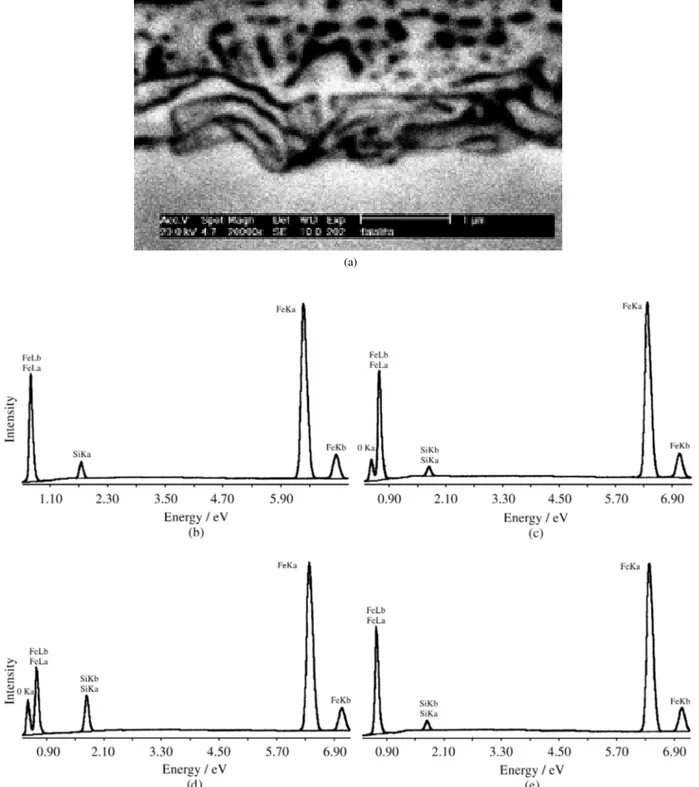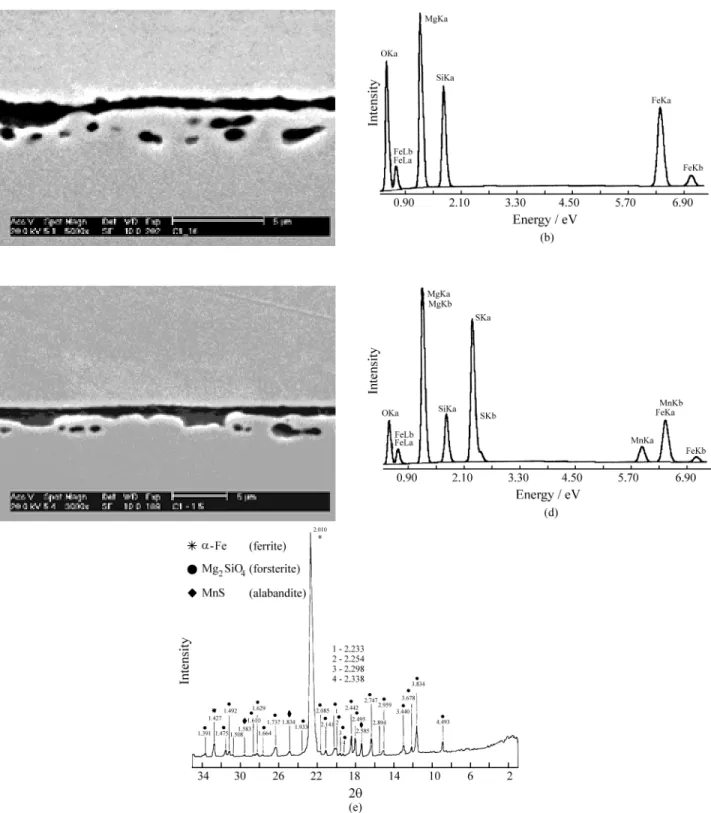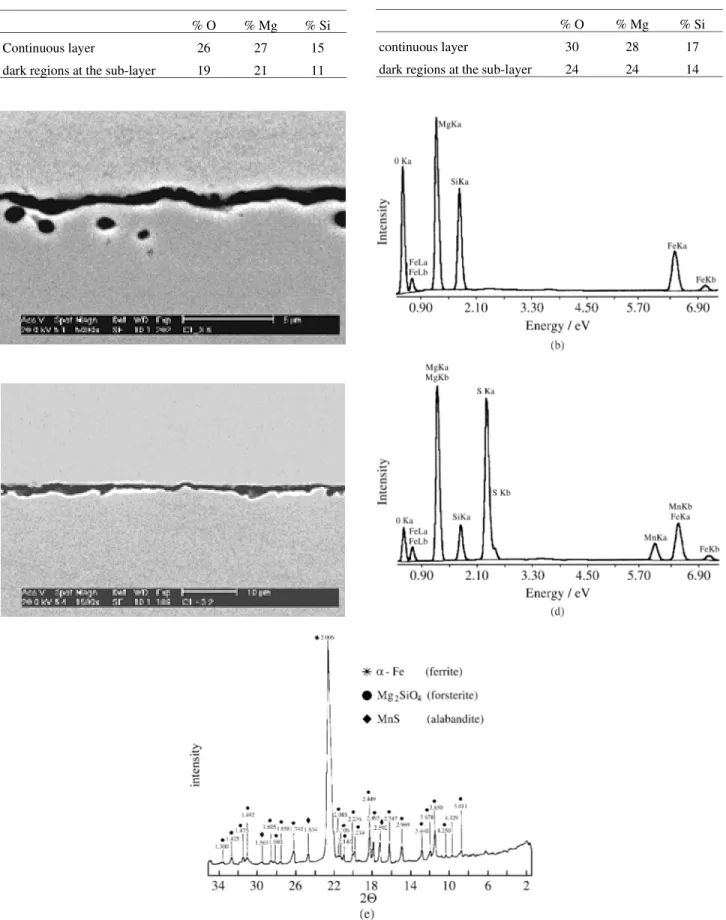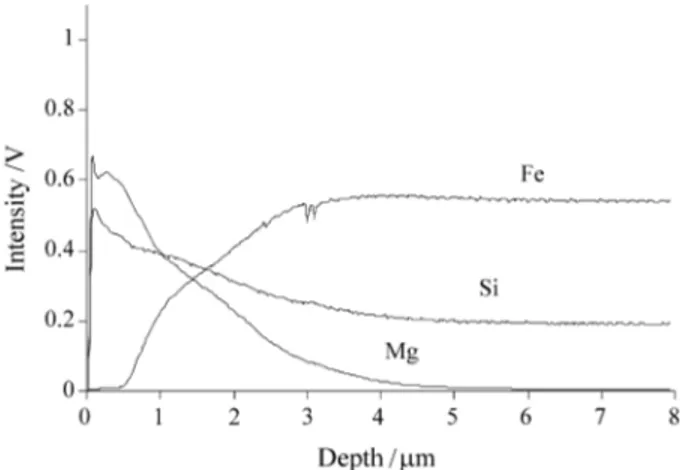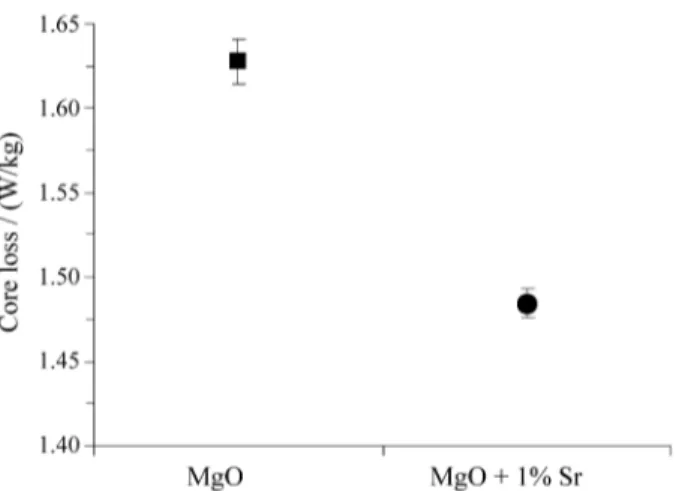Influence of MgO Containing Strontium on the Structure of
Ceramic Film Formed on Grain Oriented Silicon Steel Surface
Daniela C. Leite Vasconcelos
a, Maria das Graças M.M. Cesar
a,
Marco Antônio da Cunha
a, Wander L. Vasconcelos
baCentro de Pesquisa e Desenvolvimento, ACESITA
bDepartamento de Engenharia Metalúrgica e de Materiais, UFMG
Received: August 15, 1998; Revised: March 30, 1999
The oxide layer formed on the surface of a grain oriented silicon steel was characterized by SEM and EDS. 3% Si steel substrates were coated by two types of slurries: one formed by MgO and water and other formed by MgO, water and SrSO4. The ceramic films were evaluated by SEM, EDS and X-ray diffraction. Depth profiles of Fe, Si and Mg were obtained by GDS. The magnetic core losses (at 1.7 Tesla, 60 Hz) of the coated steel samples wereevaluated as well. The use of MgO containing strontium reduced the volume fraction of forsterite particles beneath the outermost ceramic layer. It was observed a reduced magnetic core loss with the use of the slurry with MgO containing strontium.
Keywords: ceramic film, forsterite particles, grain oriented silicon steel, magnetic core loss
1. Introduction
The grain oriented silicon steel has been used as a magnetic core material of electrical equipment and is re-quired to have low core loss, high permeability and proper dielectriccoating1,2.
In order to present low core loss and high magnetic permeability the silicon steel must develop during the secondary recrystalization (with the aid of MnS as an inhibitor) grains with a {110} <001> (Goss) orientation1,3. To avoid the coil laps from sticking during the final annealing and to provide good dielectric properties the decarburized silicon steel is coated with an annealing sepa-rator. The coating is deposited as magnesia slurry. The ceramic film (forsterite) is formed from a reaction between the steel surface and the magnesia. Additives have been added to the magnesia to provide stabilization of the sec-ondary recrystalization process and also to provide a stable formation of forsterite4,5.
The objective of this work is to evaluate the influence of a MgO containing 1% Sr (as SrSO4) on the structure of the ceramic film formed on the surface of a grain oriented silicon steel.
2. Experimental
The substrates used in this work were silicon steel samples supplied by Acesita SA and obtained just after the decarburization. They were coated with slurries kept at 5 °C. One slurry was prepared with 10% MgO and another with 10% MgO + 1% Sr (added as SrSO4 and calculated as a function of the MgO weight). The coated samples were heat treated up to 1200 °C for 15 h in a hydrogen atmos-phere.
The surfaces of the steel substrate and coated steel sheets were characterized by SEM (Philips XL30) and EDS (EDAX-DX4). The coated steel samples were also charac-terized byX-ray diffraction (Rigaku–Geiger flex) and glow discharge spectrometry – GDS (depth resolved, radio fre-quency glow discharge atomic spectrometry, with a Jobin Yvon 5000RF).
The core losses measurements were conducted under an alternating magnetic field of 1.7 Tesla at 60 Hz by SST (Single Sheet Tester) testing method with a Brockhaus Messtechnikequipment.
3. Results and Discussion
During the decarburization stage a layer of oxides with 2.1 ± 0.5 µmwas formed on the steel sheet surface, as
a
research@acesita.com.br
shown by the cross-section photo in Fig. 1a. That oxide layer was identified as amorphous silica (SiO2) and fayalite (Fe2SiO4)6. Considering the elements Fe, Si and O four regions were identified by EDS, which are shown in Fig. 1a. Point 1 (Fig. 1a) refers to a typical chemical
composi-tion of the steel sheet, with around 2.5 ± 0.5 (wt)% Si, as shown by the EDS spectra in Fig. 1b. (All the results of EDS composition used in this work are expressed in weight percent.) Figure 1c is related to the light grey oxide layers closer to the outermost surface, represented by point 2, with
1.9 ± 0.4% Si. The dark regions shown by point 3 presented 5.8 ± 1.3% Si, as shown in Fig. 1d. The light grey regions closer to the outermost surface present smaller Si content than the steel sheet and O content smaller than the darker regions and are associated with fayalite. The dark regions present higher Si and O contents and are associated with
the presence of silica. At the inner parts of the surface layer, the light grey regions represented by point 4 (EDS spectrum shown in Fig. 1e) present 1.8 ± 0.3% Si, no oxygen and may be associated with metallic Fe.
After the final annealing at 1200 °C for 15 h, the impurities elimination, the secondary recrystalization and
Table 2. EDS data for the film formed by MgO + 1%Sr.
% O % Mg % Si
continuous layer 30 28 17
dark regions at the sub-layer 24 24 14
Table 1. EDS data for the film formed by MgO.
% O % Mg % Si
Continuous layer 26 27 15
dark regions at the sub-layer 19 21 11
the formation of the ceramic film on the sheet surface occurred.
Figure 2a presents a typical morphology of the ceramic film formed after the MgO slurry deposition. The continu-ous layer is relatively richer in oxygen, magnesium and siliconthanthe dark regions at the sub-layer, as shown in Table 1.
While the stoichiometric ratios of the forsterite (Mg2SiO4) components are Mg/Si = 1.7 and Mg/O = 0.8 (in weight), the measured ratios were Mg/Si = 1.8 and Mg/O = 1.0 for the continuous layer and Mg/Si =1.9 and Mg/O = 1.1 for the dark regions at the sub-layer. These facts strongly suggest that the dark particles and the surface layer are composed of forsterite. Figure 2b shows the EDS spec-trum obtained for the continuous layer. Another typical morphologyof the film formed with MgO is shown in Fig. 2c, where the continuous layer presents some thicker re-gions. In these regions (point 1 and 2 in Fig. 2c), one can find, besides the elements of the forsterite, the presence of S and Mn, which are used as grain growth inhibitors. The EDS analysis of points 1 and 2 are very similar and indicate the presence of 17% O, 29% Mg, 8% Si, 20% S and 6% Mn, as shown in Fig. 2d.It is shown by X-ray diffraction analysis (Fig. 2e) that the components of the ceramic layer are forsterite and alabandite (MnS).
The film obtained with the MgO + 1% Sr slurry is shown in Fig. 3a. Figure 3b presents the EDS spectrum obtained for the continuous layer of Fig. 3a. The continuous layer is relatively richer in oxygen, magnesium and silicon than the dark regions at the sub-layer, as shown in Table 2. The film formed with MgO + 1% Sr also presents regions with no forsterite particles, as shown by Fig. 3c. By EDS analysis it is possible to observe the presence of Mn and S in some thicker regions, such as at point 1 of Fig. 3c. This region presents 13% O, 29% Mg, 6% Si, 25% S and 7% Mn, as shown the EDS spectrum of Fig. 3d. The X-ray diffraction analysis, Fig. 3c, showed the presence of for-sterite and alabandite on the surface of the sheet.
It can be observed that the chemical composition of the film formed after the annealing is independent of the chemical composition of the slurries used in this work. The ceramic film formed by MgO presents a thickness of ca. 1.1
± 0.4 µm while the film obtained with the MgO + 1% Sr presents a thickness of 1.2 ± 0.5 µm. However, the ceramic films can be differentiated concerning their morphologies. Using image analysis, it was possible to evaluated the ceramic film concerning the relative volumes that the con-tinuous layer and the forsterite particles present at the sub-layer. As shown in Figure 4, the film formed by the MgO + 1% Sr presented a smaller volume fraction of forsterite particles beneath the outermost surface layer. The data points shown in Figure 4 represent the average of 6
experiments of volume fraction evaluation. Each experi-ment was carried out in a field of 80 µm of length.
The chemical composition depth profiles considering the elements Fe, Si and Mg, evaluated by GDS analysis are shown in Fig. 5 for the film obtained from the MgO slurry and in Figure 6 for the film obtained from the MgO + 1% Sr slurry.
Usually, the intensity data from the GDS analysis is recorded as a function of time. The intensity vs. time data is then converted to intensity vs. depth by multiplication of the average sputter rate. So, the depths on the graphs shown on Fig. 5 and Fig. 6 are approximate. The intensity is proportional to the amount of element present in the plasma, which is controlled by the concentration of the samples and by the sputter rate. The intensities for Fe and Mg have been normalized for each sample (signal/5), so that the profiles could be presented on one scale.
Since the samples were prepared by heat treatment, the surface components diffuse gradually into the sample sub-strate (Fe). It can be observed by Fig. 5 and Fig. 6 that the pure ceramic layers (when the Fe presents little signal) for
Figure 4. Volume fraction of forsterite particles in the film formed by MgO and MgO + 1% Sr.
the two samples are around 1 µm thick. The depth profile also confirms the data shown in Fig. 4. The surface area tested on each sample is around 12.5 mm2 and the GD plasma sputters and atomizes this area in a layer-by-layer fashion. Thus, after ca. 1 µm, the result presented refers to the forsterite particles in a Fe matrix. In other words, the sample with smaller amount of forsterite particles in the sub-layer present a sharp decrease in the Si and Mg contents after a distance of ca. 1 µm, as shown for the film obtained from the MgO + 1% Sr slurry in Fig. 6.
The forsterite particles formed directly beneath the surface of a silicon steel sheet hinder the magnetic domain wall migration and cause a higher core loss of the steel sheet. Fig. 7 shows the core loss (W/kg) for the two types of samples used in this work. The coating with MgO + 1% Sr presented a smaller core loss and also a smaller volume fraction of forsterite particles, according to Fig. 4.
4. Conclusion
It was possible to observe the influence of the magnesia containing strontium on the structure of the forsterite film formed on the grain oriented silicon steel. The use of MgO containing strontium reduced the amount of forsterite par-ticles beneath the outermost ceramic layer. It was observed a reduced magnetic core loss with the use of the coating with MgO containing strontium.
References
1. Cunha, M.A. Cesar, M.G.M.M. IEE Transaction on
Magnetics, v. 30, n. 6, p. 4890-4892, 1994.
2. Nippon Steel Corporation, Japan, Hiroaki Masui, Morio Shiozaki, Nobuyuki Takahashi, Hisashi Kabayashi, Takeo Nagashima, Shuichi Yamazaki, Hi-royasu Fujii. Grain Oriented Silicon Steel Sheet
Hav-ing Excellent Primary Film Properties. Int. Cl6.
B32B15/04. U.S. P. n . 5,565,272. 10 Jul. 1992; 15 Oct. 1996.
3. Kawasaki Steel Corporation, Japan, Nobuyuki Morito, Toshitomo Sugiyama, Yasuo Yokoyama, Toshio Ichida. Method of Forming an Insulating Film
on a Grain Oriented Silicon Steel Sheet. Int. Cl3.
H01F1/04. U.S. P. n . 4,242,155. 23 Apr. 1979; 30 Dec. 1980.
4. Cesar, M.G.M.M. Influência de Diferentes Tipos de Lama de Magnésia na Qualidade Física do Revesti-mento Primário e na Qualidade Magnética de um Aço
Silício de Grão Orientado. Belo Horizonte, Master
Thesis. Universidade Federal de Minas Gerais, 1993. 5. Armco INC., Wade S. Wright, Robin A. Murphy. Magnesium Oxide Coating for Electrical Steels and
the Method of Coating. Int. Cl5. H01F1/04. U.S. P. n
5,192,373. 12 Apr. 1991; 9 Mar. 1993.
6. Yamasaki, T. Transactions ISIJ, v. 9, p. 66-75, 1969. Figure 6. GDS intensity of Fe, Si and Mg as a function of depth from the
